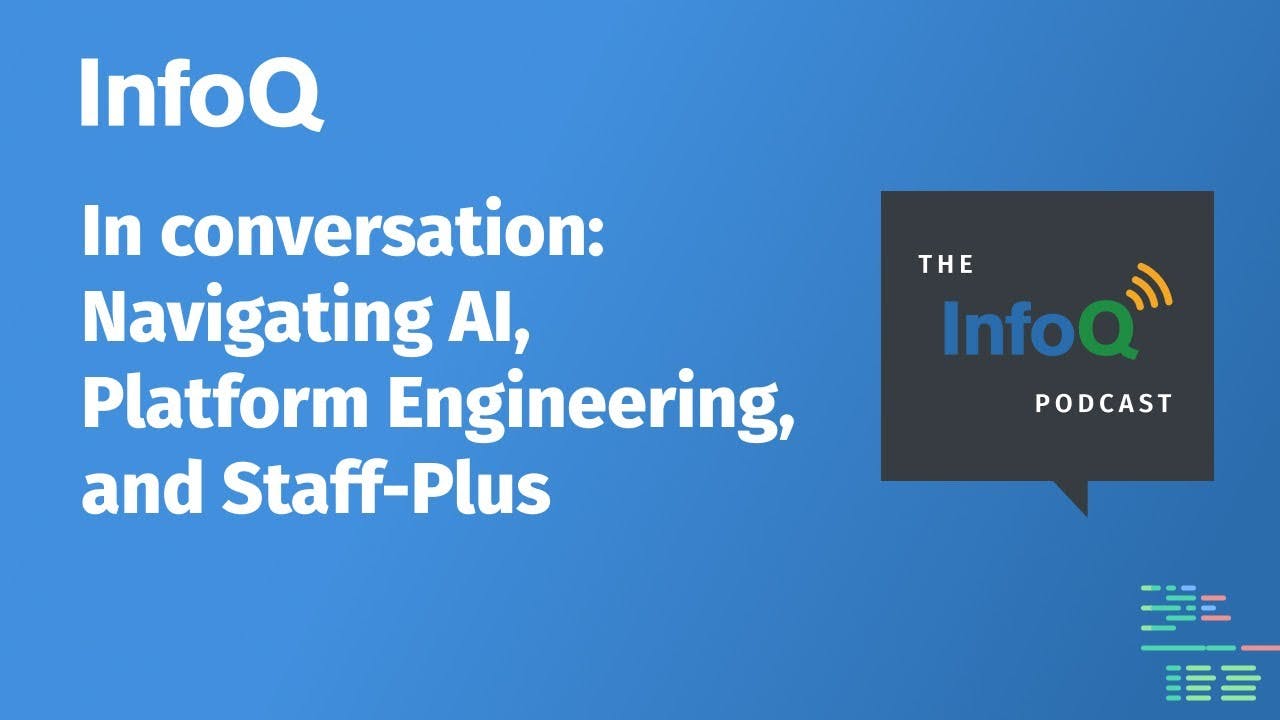Navigating AI, Platform Engineering, and Staff-Plus: InfoQ Dev Summit Preview
()

AI in Software Development
- AI tools like Copilot can boost developer productivity by generating code and test cases, but developers should review and modify the generated code to ensure it meets their standards.
- AI can help developers navigate complexity by prioritizing user feedback, understanding codebases, and visualizing complex systems.
- AI can assist in onboarding new team members by answering simple questions and providing information about complex codebases.
- Platforms can use AI to provide users with tailored documentation and instructions based on their specific use cases.
- AI can help developers stay ahead of the curve by providing insights and recommendations based on the latest advancements in technology.
Software Architecture
- There is no one-size-fits-all architecture for all use cases. The right architecture depends on factors such as the company's platform, the team's understanding of their domain, and the desired level of coupling and cohesion.
- Microservices and monolithic architectures have their own advantages and challenges. Striking a balance between shared code and decoupled deployment is crucial.
- Developers tend to get distracted by new technologies and swing from one approach to another. Learning from others' experiences and avoiding repeating mistakes is essential.
- Shifting security and reliability considerations earlier in the development lifecycle is important, but developers need the right tools and patterns to effectively implement these concerns.
- Codifying best practices and establishing standardized patterns can help developers make informed decisions about architecture, costs, and security.
- Platform engineers should provide standardized ways for engineers to consume security, logging, and observability tools.
- The evolution of platforms and microservices has made it easier to build applications, but there is still a challenge in balancing early investment in performance tuning with the need to iterate and optimize as bottlenecks emerge.
Platform Development
- The concept of "platform as a product" involves treating the platform as a product in its own right, with a focus on customer needs and pain points.
- Team topologies can be seen as an API for teams, defining roles, responsibilities, and SLAs/SLOs.
- Successful platforms are created by understanding customer struggles and building solutions that address those pain points, rather than creating platforms based solely on engineering assumptions.
- Finding the right balance between internal developer needs and customer-friendly platforms is important, as is aligning product input from the right people without creating bottlenecks.
- Every company's team structure and platform approach may differ based on historical context and specific needs.
Career Development in Software Engineering
- The concept of staff engineers and staff plus roles is relatively new in the software development industry, emerging within the last 10 years.
- There has been a shift in the understanding of career tracks and roles in software development, with more formalized levels and specialized positions.
- The book "The Staff Engineer" by Will Larson provided groundbreaking insights into the role of staff engineers as senior individual contributors.
- The management track in engineering has also seen significant development, with the emergence of books like "The Manager Path" that define roles such as engineering manager, tech manager, and director.
- Despite these advancements, there is still a lack of quantifiable criteria for promotions from senior to staff or from tech lead to engineering manager.
- The transition from senior engineer to staff engineer is often misunderstood as a simple progression, but it actually requires a significant shift in responsibilities and mindset.
- Staff engineers are often categorized into archetypes such as tech lead, architect, silver bullet, and right-hand click, with the majority falling into the tech lead and architect categories.
- The role of staff engineers involves a broader perspective and a focus on the bigger picture compared to senior engineers.
- While it is a natural career progression for some senior engineers who want to continue as individual contributors, it is also perfectly acceptable to remain at the senior level and focus on learning new skills and technologies.
- There are variations in career ladders across different companies, making career growth challenging.
- Some individuals prioritize career advancement and increased compensation, leading to potential job dissatisfaction.
- Creating more opportunities for growth within specific roles, without necessarily requiring title changes, could be beneficial.
- The perception of senior engineers as failures due to not advancing further up the career ladder is a misconception.
- Not everyone is suited for management positions, and many find fulfillment in impactful roles as managers.
- The speakers suggest creating a separate title for staff engineers to differentiate it from the IC ladder.
Conference Information
- The upcoming talks at the conference will cover topics such as building successful platforms, strategies for staff engineers, and security for developers beyond authentication and authorization.
- Boston is highlighted as a great place to visit, with its attractions and the opportunity to watch a Red Sox game.